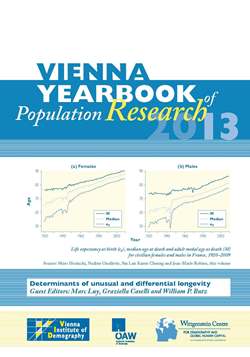|
 |
Introduction
Graziella Caselli and Marc Luy: Determinants of unusual and differential longevity
Refereed Articles
Elizabeth Wrigley-Field: Mortality deceleration is not informative of
unobserved heterogeneity in open groups
Shiro Horiuchi, Nadine Ouellette, Siu Lan Karen Cheung and
Jean-Marie Robine: Modal age at death: lifespan indicator in the era of
longevity extension
Jon Anson: Surviving to be the oldest old—destiny or chance?
Michel Poulain, Anne Herm and Gianni Pes: The Blue Zones: areas of exceptional longevity
around the world
Luis Rosero-Bixby, William H. Dow and David H. Rehkopf: The Nicoya region of Costa Rica: a high longevity
island for elderly males
Sebastian Klüsener and Rembrandt D. Scholz: Regional hot spots of exceptional longevity in
Germany
Richard G. Rogers, Patrick M. Krueger, Richard Miech and
Elizabeth M. Lawrence: Lifetime abstainers and mortality risk in the
United States
Maria Winkler-Dworak and Heiner Kaden: The longevity of academicians: evidence from the
Saxonian Academy of Sciences and Humanities in
Leipzig
Morgan E. Levine and Eileen M. Crimmins: Evidence of resiliency among long-lived smokers
Ethan J. Sharygin and Michel Guillot: Ethnicity, russification and excess mortality in
Kazakhstan
Graziella Caselli, Rosa Maria Lipsi, Enrica Lapucci and James W. Vaupel: Exploring Sardinian longevity: women fertility and
parental transmission of longevity
Valérie Jarry, Alain Gagnon and Robert Bourbeau: Maternal age, birth order and other early-life
factors: a family-level approach to exploring
exceptional survival
Leonid A. Gavrilov and Natalia S. Gavrilova: Determinants of exceptional human longevity:
new ideas and findings
Luisa Salaris, Nicola Tedesco and Michel Poulain: Familial transmission of human longevity:
a population-based study in an inland village of
Sardinia (Italy), 1850–2010
|



